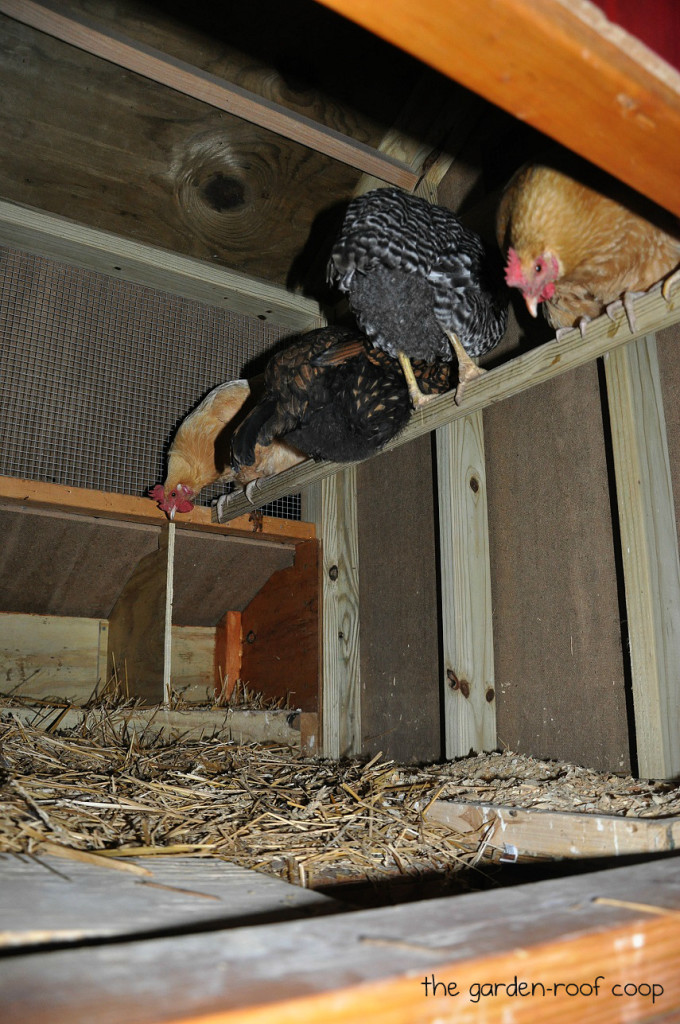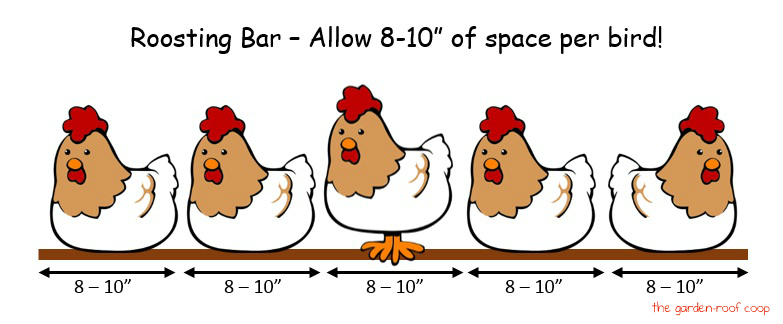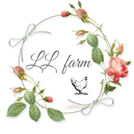Warning: If you have backyard chickens – you’ll be inclined to want MORE backyard chickens!

When I first entered the world of backyard chicken keeping, I thought four hens would meet my needs: 4 eggs a day X 7 days = 21 eggs per week. That’s plenty of eggs for a family of four, but I didn’t realize that hens aren’t just about providing you with delicious eggs. – They each have unique personalities, endearing antics, gorgeous feather patterns, provide free entertainment… the list goes on and on. Suddenly 4 hens wasn’t enough!
Over the years I’ve averaged about 7 – 8 hens in my medium sized coop. I have three nesting boxes (1 box / 5 hens is the requirement) – and usually the girls share only one of the nesting spots. The coop size is a little shy of the recommended space for a flock of 8, but the hens free range during the day and spend little time actually inside the coop. I added an extra roosting bar a couple of years ago which allows more sleeping spots, but how much space does a chicken need to comfortably rest at night? Is a roosting bar an essential element in poultry housing?
According to Storey’s Guide to Raising Chickens by Gail Damerow, here are the specs for a roosting bar:
Wild chickens roost in trees. Many of our domestic breeds are too heavy to fly up as high as a tree limb, but still like to perch off the ground. You can make a perch from an old ladder or anything else strong enough to hold chickens and rough enough for them to grip, but without being so splintery it injures their feet. If you use new lumber, round off the corners so your chickens can wrap their toes around it. Plastic pipe and metal pipe do not make good roosts: they’re too smooth for chickens to grasp firmly. Given a choice, chickens prefer to roost on something flat, like a 2 by 2 – with rounded edges.
The perch for regular-size chickens should be about 2 inches across. Allow 8 inches of perching space for each chickens, 10 inches for the larger breeds. If one perch doesn’t offer enough roosting space for your number of birds, install additional roosts. Place them 2 feet above the floor and at least 18 inches from the nearest parallel wall, and space them 18 inches apart. If floor space is limited, install roosts in stair-step fashion 12 inches apart vertically and horizontally, so chickens can easily hop from lower to higher rungs.
As for the benefits of perches – I’ll refer to the following info provided by Dr. Jacquie Jacob – a poultry extension associate at the University of Kentucky.
Providing laying hens with perches is a way to relieve their stress and to reduce certain injuries and cannibalism. During the day, hens that are lower in the pecking order use the perches to escape pecking from more dominant hens. This ability to escape reduces the incidences of injury to the head and neck caused by aggressive pecking and cannibalism caused by severe feather pecking. At night, when all the hens perch, the more dominant hens take the higher perches.
Perches can play a role in manure management as well. Perches allow birds to stay off the floor, particularly during the night. Consequently, manure tends to accumulate under the roost area, and the rest of the bedding material in the house stays cleaner.
The use of perches also can affect egg laying. A higher level of floor eggs has been reported for flocks without access to perches.

This year I was down to 6 hens and decided to add 3 more to the flock. – However, I had a hard time trying to decide which breeds I wanted and ended up purchasing 4 more pullets! That impulsive decision increased my flock size to 10 birds. I have 2 roosting bars – one is 43 inches – another one is 33 inches. At 8 inches space per bird, that allows for about 9 hens (without any wiggle room). I do have one chicken that for some odd reason has never used a roosting bar (she nests on the floor of the coop). I recently combined the two flocks (young pullets – mature hens) and the quarters are pretty snug. It’s not much of a problem now – other than a lot of squirming and pecking while the little girls are learning their position in my hierarchy of hens. However, in my experience I’ve learned that once the outside temps go below freezing, the flock spends much of the day inside the coop – and that’s when there might be an issue with not enough space to ruffle their feathers…
Take my advice – before you increase your flock size – consider how many birds your setup can accommodate safely and comfortably. Then have someone else purchase the chicks so that you won’t be tempted to get “just one more”!!
Share your tips and suggestions concerning roosting bars in a comment below. Share your photos on our Community Chickens Facebook page!
To view what else is happening at my Southwest Missouri property visit: the garden-roof coop
If you enjoy bird-watching (in addition to chicken-watching), I invite you to follow my Facebook page: Rebecca’s Bird Gardens













6 Comments
I am building my nesting boxes, 2 rows of 4 nests, stacked. the floor on the fist row is 18″ above the coop floor, the second row is is 12″ above that. I see some nesting boxes with a “Perch” level with and in the front of the nest, is this needed?
My hens only three so far, roost on top of the coop. I live in a very warm climate year round. My hens free range, and use the coop for shelter from the rain, and to lay in the nesting box. the coop is in a fenced area with fencing stations attached to the fence. They seem to really like that. My problem is that they roost on top of the coop, so every morning I clean poop. I made a roost a couple feet taller than the coop. they wont even go on it. There is only one bar, and it is about five feet high. Should it be lower?
Thanks for your help
It may be the solidity of the roof that they like. It’s not as narrow as a bar. You might tack paper under where they roost to make clean up quicker. You could them put the paper in your compost pile where it will degrade quickly. Unbleached paper (newsprint if you can find rolls of it) works well and won’t add chemicals to your compost.
Instead of a 2×2 we use a 2×4 lead flat. Bigger birds with larger feet will have a bigger chance of exposed toes in cold, windy northern winters. On the 2×4 the feet will lay flat and the feathers and body cover the exposed toes fully. In warmer climates that may not be an issue.
Hi
just need help i am new to chickens, just bout a 7×8 coop, that has this amount of space on the floor, but goes narrow on top, barn style I guess. The question is the nesting boxes are about 21/2 feet up on one side, then a ladder on the other side for a roost but this is equal to the height of the nesting boxes, and goes down, should i rove this ladder, and just make an 8 foot long roost opposite the nesting boxes so it would be a little higher? they would then need a ladder right?
Was also thinking of a drop board under the roost, how would i support the 8 foot long roost need to make sturdy
thanks
Sheri
I find that my ladies need more space, mostly to get up onto the roost. Mine are about 12 inches high, and the ladies like to spread their wings to hop up, so they need more space to get there. Once there, however, I agree that they mostly jam together as close as possible.